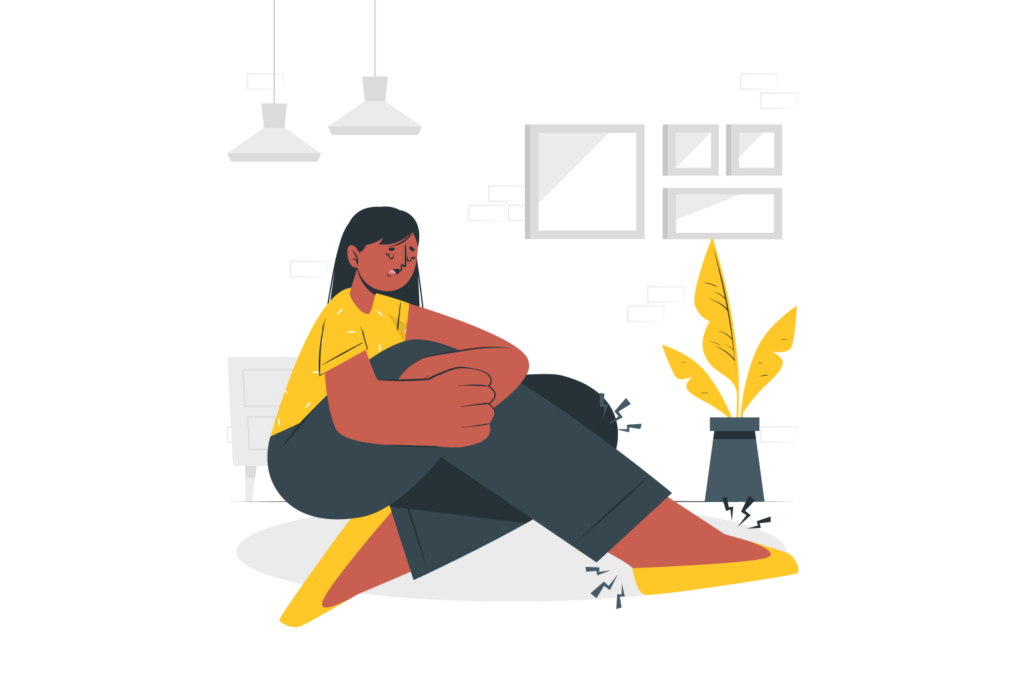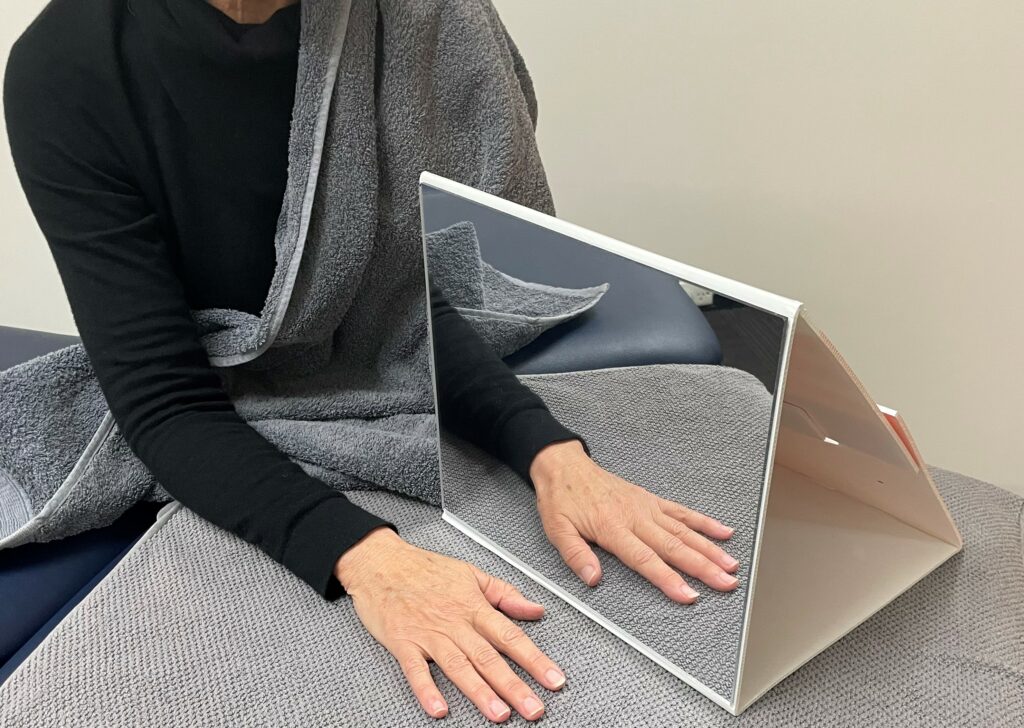Condition · 8 min read · 25 Jun 2022
Learn about complex regional pain syndrome and get tips to help you manage
Getting credible and helpful information can help you recover and manage your pain and improve your life quality.

Getting credible and helpful information can help you recover and manage your pain and improve your life quality.

Emma’s 16 years old and loves playing netball. Nine months ago, Emma twisted her ankle. The ankle was painful and swollen, but she didn’t worry about it, thinking “this is normal after a sprain”.
But over the following weeks and months, Emma described experiencing severe, distressing, and persisting pain, and strange sensations in her ankle and foot: “It feels like ants are crawling all over my ankle and foot – like it’s burning, numb but so painful, and blue and cold all the time. It’s like it isn’t part of me anymore.”
Emma couldn’t even bare to touch her own skin. It was so painful – even putting on a shoe or socks left her in tears. She had stopped playing netball and had an ongoing limp. She had trouble sleeping, studying, socialising and was feeling really low.
Emma had seen the doctor. She had x-rays and tests to check for any nerve injury. These investigations were all clear, so she knew she didn’t have a broken bone or nerve damage.
Emma was finally diagnosed by a pain specialist as having Complex Regional Pain Syndrome (CRPS), Type 1.
Sometimes, it can be hard to find the support you need from a health team; you may have had negative experiences of your pain being disbelieved, or you just haven’t been able to find people who know how to treat you. Check out our management modules for help on this Helping Others Help You and Further Contacts.
Emma’s now getting the care she needs to help her manage, work towards recovery and to getting back to the things she loves doing. Her journey will be slow with bumps along the way, but there is a way forward for Emma.
Most young people do recover from CRPS. Getting the right care at the right time can make a difference to the outcomes from CRPS. For young people with CRPS, there is hope and a way forward.
As a young person living with CRPS, Maja de Langen eloquently describes her experience and journey through CRPS in her thesis, Interactions with Persistent Pain: Knowing and Enacting the Painful Body

The following content is designed to help you, to provide guidance and links to further resources and support.
CRPS is a pain condition that usually starts after a simple injury or sprain, or following surgery or trauma (such as a broken bone). In rare cases, there may be no trigger.
CRPS can have a profound, negative and enduring and unique impact on young lives.
We currently don’t fully understand why CRPS develops. We do know CRPS involves our nervous, immune, autonomic and endocrine systems. The nervous system becomes overly sensitive and overprotective, impacting our ability to do even simple everyday activities without pain. CRPS can also affect our mood and thinking.
The hallmark features of CRPS are severe pain, beyond what seems to make sense from a minor sprain, strain or minor nerve injury. CRPS usually starts with pain at the site of injury, with the pain spreading over time across a wider area.
There are different stages of CRPS:
Like other pain conditions, every person is affected differently, and CRPS varies in nature, severity and duration. Other conditions can co-exist with CRPS, like Chronic Widespread Pain or Juvenile Idiopathic Arthritis. Some young people also experience anxiety and depression.
Like all pain, there are lots of other factors that can impact or influence an experience of CRPS. We address these factors a little later and explain why care needs to consider your needs as a whole person.

CRPS most often occurs after simple injuries, such as a sprained ankle or a broken arm. There are different subtypes of CRPS:
The transition of CRPS to a more prolonged and complex condition to manage in young people, seems to occur during the first 12-18 months after onset.
There is no gold standard x-ray or imaging test, or laboratory, genetic, or electrical diagnostic (nerve) test to confirm a CRPS diagnosis.
Not all health professionals know enough about CRPS to easily identify it in young people. We also don’t yet have a specific screening questionnaire that helps to identify CRPS in young people. This is why CRPS is sometimes missed.
Although developed for adults, a list of signs and symptoms called the Budapest criteria are commonly applied clinically to screen young people with suspected CRPS.
For young people, a suspected diagnosis is often what is clinically accepted as the basis for care, unless there is an alternate diagnosis.
All young people with suspected CRPS are recommended to have an early assessment by a health professional with expertise in CRPS, to check if a diagnosis of CRPS is possible or likely. This is usually a doctor or physiotherapist.
There should be no other diagnosis that could better explain the pain and signs/symptoms.
The features that may suggest you have CRPS, include:
If you think you might have CRPS, please seek help from a health professional as a first step. This means you have a better chance of getting the right care.
As a diagnosis can be tricky, it’s a good idea to take the list of symptoms you have when you seek help.
This can often guide the clinician to understand that CRPS is a possible diagnosis and they can take the next steps to help you get the care you need.
Young people with CRPS often struggle with the invisibility of their pain and the lack of understanding, empathy, or even acknowledgement from their friends, peers and family for how severe, distressing and impactful CRPS can be.
Myths about CRPS remain a big issue here. Myths can come from health professionals, family, friends, teachers, and the broader community.
Myths come from a lack of understanding about CRPS, poor recognition of CRPS and a delay in the diagnosis of CRPS. These factors all contribute to perpetuating unhelpful myths about CRPS.
Myths can be disheartening, leaving you feeling deflated and fearful about your future life. Myths can also influence your mindset, so you do not feel in control of your health.
Understanding what is true about CRPS is a critical first step to helping you manage your CRPS.
Myths about CRPS are common and unhelpful. The opposite of these myths is true. Let’s break them down!
Myth: CRPS pain means my limb is damaged
Fact: CRPS in young people is rarely associated with serious tissue damage or pathology
Myth: CRPS is all in my head
Fact: CRPS is real and pain is not your fault: try and seek care from supportive health professionals with experience of CRPS
Myth: CRPS pain is just a physical, structural problem
Fact: CRPS is affected by lots of factors: stress, poor sleep, low mood, inactivity or overactivity, lack of movement, fear and worry, wrong care
Myth: CRPS means you need to rest and protect your limb
Fact: Desensitisation of your limb to pressure, touch and movement through graded exposure and carefully graded activity and movement is critical to your recovery
Myth: It is dangerous to move and exercise with CRPS
Fact: You recover better and get healthier and stronger with careful desensitisation, graduated movement, activity and exercise
Myth: You need to use a brace or sling to protect your limb
Fact: Braces and slings are usually unhelpful in managing CRPS! Your health team will guide you
Myth: It’s not safe to put weight on my affected painful limb
Fact: Using your affected limb may cause discomfort, but it’s not harmful. Gradually increasing limb movement and loading makes it stronger over time and less painful
Myth: Ongoing pain means my affected limb is being damaged
Fact: Ongoing pain is related to hypersensitivity of the body to activity, load and movement. This sensitivity is related to many factors but is rarely linked to tissue damage
Myth: There is nothing you can do for CRPS
Fact: With the right support, provided at the right time, you can improve, manage and recover from CRPS
Myth: CRPS will get worse with time
Fact: With the right care and support, your CRPS does not always get worse over time, you can improve and recover
Myth: A pain flare-up means I have re-injured my limb
Fact: Pain flare-ups are common and are usually caused by factors such as overdoing things, inactivity, stressful events and low mood. Sometimes pain flares happen for no apparent cause
Myth: Medicines are the best treatment
Fact: Medicines in CRPS have very limited benefits and come with risks. Right care includes regular “doses” of physiotherapy/occupational therapy to help desensitise your limb, and start you safely moving, help you strengthen up and become more flexible and psychological care to help you learn ways to manage CRPS and support your recovery
For CRPS in young people, we currently don’t have trustworthy evidence about which treatments do work – but we do have evidence of treatments that don’t. Despite this, there are many care approaches that can be tried in order to help with CRPS.
Below we have summarised the steps to the current best care approach for young people with CRPS.
You can also check out our CRPS recommended care fact sheet. Please make sure you discuss your care with your health professional, to ensure you discuss and get the right care plan for you.
Here’s some things to discuss when you’re developing a plan, as everyone’s CRPS pain is different:
Your doctor is likely to be part of this team too. Care you should expect includes the following:
These care approaches might be led by your physiotherapist, an occupational therapist or in collaboration with an exercise physiologist. Remember, it’s important to discuss with your team what might be helpful for you.
Desensitisation means using activities to help your system re-learn that everyday things like touch, pressure and movements are safe.
While desensitisation activities may initially cause a short-term increase in sensitivity, this is usually short-lived. Start with something that only causes a small increase in sensitivity, gradually building up until it no longer causes pain flares. As you repeat these exposures on a regular basis, sensitivity should gradually decrease.
Here’s an example of a desensitisation approach that helped one young person’s recovery:
CRPS can be really intense and scary, and even small movements can hurt. Your limb might feel like it “seizes up” as a protective response to the pain.
Mirror box therapy involves hiding your affected hand from your sight and focusing on viewing a mirror image of your unaffected hand doing specific functional activities. This tricks the eyes and brain into thinking it’s your affected limb moving, although it’s the unaffected reflected limb.
This graded motor imagery approach is designed to help re-train your system to be less sensitive to normal everyday inputs and learn that it’s safe to move your affected limb.
This activity is often done by showing you images of both limbs in different positions and asking you to recognise which limb it is.
This activity may be timed and used as an activity to progress your recovery. Ask your physiotherapist or occupational therapist for more information.

A targeted rehabilitation plan can also help.
For each individual, the needs are different. It’s important for your team to link your goals to the targeted rehabilitation that works for you. This might include doing gentle activities with lower demand, such as:
Gently stretching and moving
Taking deep, long, slow breaths
Hanging out with family or friends
For more info, check out our modules on Yoga, or our mindfulness meditation.
As part of the core CRPS health team, support from a clinical psychologist is common.
Clinical psychologists work closely with physiotherapists, doctors and specialists to support you and your care. Seeing a clinical psychologist can support and help you with learning new ways to:
Our pain management modules have been designed to support your care as a whole person.
Your health team can also work with you to identify and support you with practical tools to manage the other factors that can impact your pain. These include:
Right now, we do not have trustworthy evidence for the use of medicines in the management of CRPS in young people.
Clinically, the medicines that may be used range from simple analgesia (such as non-steroidal anti-inflammatory medicines) to specific medicines that calm the nervous system and topical patches such as lidocaine or topical creams (usually a combination of medicines). We discuss these medicines, their use, potential risks, side effects and benefits in our Medicines and Pain module. This content includes helpful tips on what to ask your doctor if they have recommended medicines for your care.
You can also find our downloadable 6-step fact sheet for safe medicines use in the same module.
Rarely, medical procedures may also be suggested by your doctor as part of your CRPS care.
A big issue here is that we currently do not have trustworthy evidence for whether any procedure works for CRPS in young people, how well it works and the relative risks and benefits. Most studies are poor quality or focus on adults.
Medical procedures you might hear or read about on the internet include:
Local anaesthetic blockade of the sympathetic chain. LASB is a treatment that may be offered for CRPS to help reduce pain and other symptoms.
We lack high-quality evidence to support or counter the effectiveness of local anaesthetic blockade for CRPS, though the available evidence is not encouraging. It is not possible to draw confident conclusions about the safety of this procedure. Young people should consider this information when deciding whether to agree to the treatment.
Sympathectomy is a procedure undertaken either surgically, chemically or by laser interruption to target sympathetic nervous tissue or “sympathetic chain” of nerve ganglia.
There is a lack of high-quality evidence to support or refute the effectiveness of sympathectomy in CRPS, though the available evidence is not encouraging. Because there is no good evidence for the effectiveness of sympathectomy, particularly about long-term effectiveness. It should be used with caution, in carefully selected patients, after thorough assessment, and probably only after failure of other treatment options or in palliative cases, or both. Young people should consider this information when deciding whether to agree to the treatment.
If a procedure is recommended for you, it’s important to discuss with your doctor the potential risks and benefits of any procedures.
Download our CRPS recommended care fact sheet for a summary of care recommendations.
CRPS pain can mean we become understandably over-protective of our movements, stop doing valued life activities, and become “stuck” with CRPS.
Looking back at your progress can help - regaining small activities that you value is progress.
Sustaining your efforts brings rewards.
Prepare for the bumps - have a support team and plan in place
Asking for help is important – CRPS is hard enough without having to manage alone.
Relaxing with movement and gentle daily breathing, stretching and activity helps to engage your own body’s (endogenous) pain control systems and dampen tissue sensitivity and reduce pain.
Healthy lifestyle habits like good quality sleep can make all the difference as they help to calm your nervous system, and boost your immune system and energy levels.
Being socially engaged can be hard when you’re in pain and feeling low – but it has benefits. Try and look for different ways of being socially connected that don’t push you to the limit.
Low mood, anxiety and fear are really common when you have CRPS and live with severe pain. There is help, it’s not your fault.
CRPS support groups can help - check out CRPS Network Australia and Burning Nights or Princess in the Tower
For more information visit Cochrane Plain Language Summaries and download our recommended care fact sheet on managing CRPS.